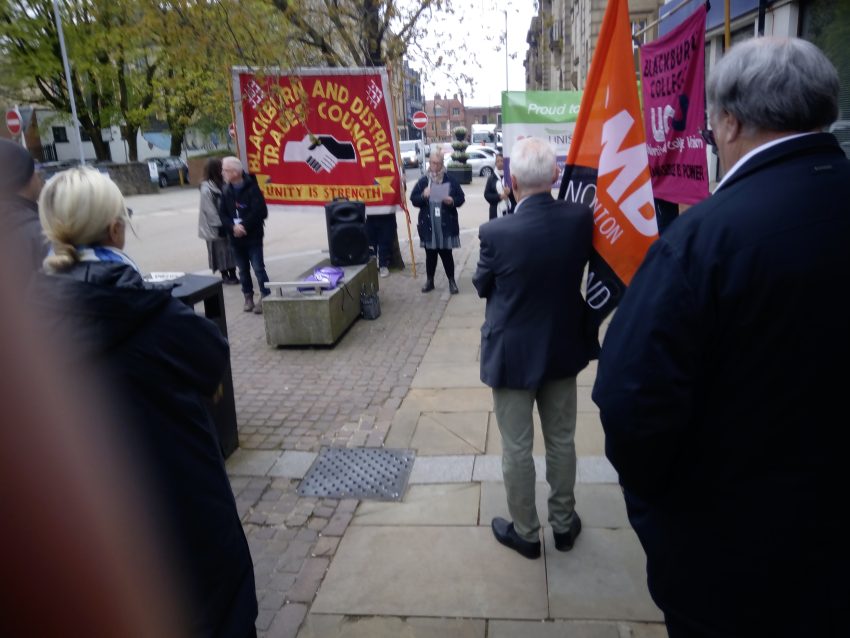Workers’ Memorial Day this year coincided with the release of a report from PROSPECT, the Union for Health and Safety Inspectors, which revealed that:
• funding for the Health and Safety Executive in 2021-22 was 43% down on 2009-10 in
real terms on a comparative basis;
• The level of cancelled mandatory investigations is at an all time high;
• Staff numbers have been cut by 35% since 2010 on a like for-like basis; and
• The number of inspectors has fallen by 41% over 20years.
“HSE under pressure: a perfect storm” concludes: “The degree of pressure that HSE is under is increasing and, if not alleviated soon, at best HSE will be unable to sustain its reputation as a respected regulator and at worst, willstruggle to exist even in diminished form”.
The latest figures from the HSE, for 2021/22) are that:
• 1.8 million working people suffered from a work-related illness, of which
• 914,000 had work-related stress, depression or anxiety, and
• 477,000 a work-related musculoskeletal disorder
There were
• 2,544 mesothelioma deaths due to past asbestos exposures (2020)
• 123 workers killed in work-related accidents
• 565,000 working people sustained an injury at work according to the Labour Force Survey
• 61,713 injuries to employees reported under RIDDOR.
But “Hazards” campaign has made the case that evidence supports a figure of up to seven times as many deaths caused by work incidents as that officially cited by the HSE. The regulator’s headline figure is limited to those deaths reported to it and to local authorities. It does not include those from other enforcement agencies, such as the Maritime and Coastguard Agency, and excludes members of the public and also those killed by occupational illness.
A more realistic estimate, which includes work-related road-traffic deaths and suicides attributed to work-related stress, is 1500-1600 a year. (For more than ten years, the Hazards Campaign has demanded that work-related road-traffic deaths are reported under RIDDOR, added to the official death-at-work statistics, and brought under the protocol for investigating work-related deaths. In recent years they have been joined in this call by the TUC, trades unions, the Centre for Corporate Accountability, RoSPA, and IOSH.)
Our speakers at this year’s commemoration event at Sudell Cross in Blackburn all, in different ways, shed light on some of the Health and Safety issues that workers face which get less attention.
Karen Reissman, UNISON Health activist and NEC member, referred to her personal experience as a Community Mental Health nurse. Not only was it not unusual for patients to present with Mental Health issues relating to work, it was Mental Health issues arising from work which were now the biggest cause of sickness in the NHS itself. She shared an anecdote about a staff meeting in a clinic where one colleague mentioned that she was starting on a new anti-depressant. It quickly emerged that everyone there was on this sort of medication, and they all started discussing which was the most effective. It was no surprise that, down the line, staff began to leave for the sake of their health. Karen emphasised that the problem was not one of “individual vulnerabilities”, but of the working environment. This was one reason why the issues of recruitment and retention were so central to the current NHS pay disputes. It was only the Unions who were prepared to be persistently vocal on these issues, and perhaps the one bit of good news was that the current strikes revealed a new level of confidence and motivation that could cross-over from the issue of pay.
Fiona Wild, a UNISON H&S Rep from East Lancashire Hospitals, also highlighted how NHS staff were facing exhaustion and burn-out following the stress put on the service by both COVID-19 and an estimated 150,000 staff vacancies. No one seemed to take seriously the issue of quantifying the increased risk from COVID for those providing close personal care, yet hundreds of nurses had died of the disease. At the same time, more NHS staff – 144 – had taken their own lives in 2021 than had died in accidents across the whole economy. Fiona had one particularly chilling statistic – doctors and nurses had a much higher rate of suicide success than other occupational groups. They knew what they were doing.
John Murphy, retired TU Tutor and past Trades Council President, spoke of the work the “Hazards” campaign was undertaking to criticise the HSE’s lack of engagement with the issue of silica dust. The HSE told “Hazards” there was neither the evidence nor the costings to justify tightening the exposure standard for this lung-shredding danger. But Hazards editor Rory O’Neill has identified that the organisation removed key evidence from its website and has ‘no information’ on the total number of workers dying nor any intention to determine related costs for one of the most potent workplace killers.
The information the HSE published and then removed showed that at an exposure limit of0.1mg/m³, as per the current regulation, it was estimated estimates that 30 in every 100 workers exposed over a working lifetime would develop life-sapping silicosis. With an estimated 600,000 workers exposed in the UK, this suggests deaths from silica-related cancers, respiratory and other diseases could now number thousands each year.
If you halve the level to 0.05mg/m³ – a standard successfully enforced in many other jurisdictions in Europe, Canada, the USA, Australia and beyond – this drops to just five in a hundred, six times fewer victims.
John emphasised that Health and Safety was one area in which Trade Union local Reps were of fundamental importance. Alex Bryson in “Health and safety risks in Britain’s workplaces: where are they and who controls them?” found that “Having on-site worker representatives dealing with health and safety is linked to lower risks than direct consultation between management and employees over health and safety”.

